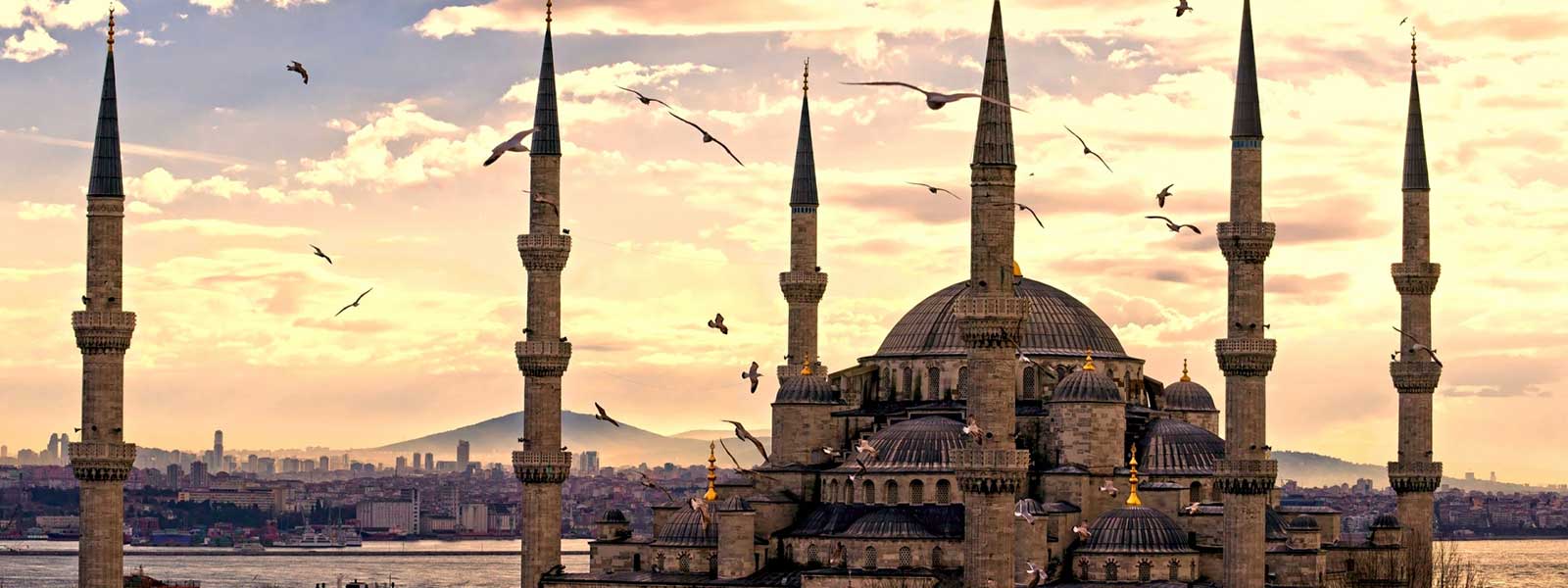
BLUE MOSQUE
Blue Mosque (also known as Sultanahmet Mosque) is one of the most famous monuments in Istanbul for both Turkey and the Islamic world. The mosque has six towering minarets and 260 windows illuminating its vast main chamber, which is decorated with more than 20,000 Iznik Tiles and also comprises a tomb of the founder, a madrasah (theological school) and a hospice. It was built from 1609 to 1616, during the rule of Ahmed I and today the mosque can be described as to dominate the skyline of Istanbul.
Ahmed I, who ascended the throne at the age of fourteen was an extremely religious-minded sultan, who displayed his religious fervor in his decision to construct a mosque to compete with Ayasofya. For the site, a suitable place was long sought before the decision was taken. At last the mosque decided to build on the site of the palace of Ayse Sultan. The owner of the palace was compensated and the site prepared by the architect Mehmed Aga, who began the construction in 1609.
This architect-poet and in layer completed this great work in 1617. An imperial lodge, school, service kiosk and single and double storied shops were included in the complex, which spread over the area around the mosque. The mosque itself is surrounded on three sides by a broad courtyard and is entered on each side by a total of eight portals. The inner court is reached through three gates and is paved in marble, and surrounded by "revak" supported on columns of pink granite and marble, and two of porphyry, and surmounted by 30 cupolas. A fine fountain for ablution takes up the center of the courtyard, surrounded by six marble columns. The mosque is unique with its six minarets in Istanbul. Four of these have three balconies, two have two balconies each, a total of 16 in all.
According to the memoirs of Mehmed Aga, the Risale-i Mimariye -the number of balconies was original to be 14 in honor of the number of Ottoman sultans, but in the 16th century, the number was increased by two, according to Incicyan, to include the sons of Yildirim Bayezid, Emir Suleyman and Musa Celebi, who had meanwhile been counted among the sultans. This mosque intended to match and compete with Ayasofya, but in reality, surpass it in proportion and the balance of internal spaces. It covers an area of 64x72 m in all.
The central dome of the Blue Mosque rests on four pointed arches with corner pendentives, which are in turn set upon four large round and fluted piers, 1.60 m in diameter. Four semi-domes, one to each side of the central dome, and small cupolas in the corners complete the roof system of the mosque. The sultan’s gallery in the left corner is flanked by the penitentiary cell of Ahmed I. Sultanahmet Mosque is given a bright and open effect through carefully calculated illumination balanced with faience decorating in the interior, as if heralding a new type of architecture.
The most original feature of the Sultanahmet Mosque is the 260 windows through which it is so well lit. Later these colored windows were repaired and consequently light entering the interior increased. However, this is said to have removed the mystic atmosphere of the interior. According to Celal Esat Arseven, the architect Mehmet Aga has attempted to create an extremely well-lit sofa (divan area).
The walls and piers are covered with faience for a third of their height to the level of the upper consoles. A total of 21043 tiles has been used in the interior. The mosque received its synonym as the Blue Mosque from the bluish haze given to the interior by these tiles. The faience consists of floral and Rumi motifs of various colors on white ground. These are very fine examples of the art of tiling. The bronze and wooden decorations and artifacts of the mosque are also very fine. Calligraphy is the work of Amethi Kasim Gubari and the fine mother-of-pearl window shutters are the work of Sedefkar Mehmet Aga. Ahmet I died in 1617 and was buried near the mosque.
The tomb, which was begun after this date, was completed in the time of his son Osman II. The building is basically rectangular with a domed portico and a square extension at the rear. The entrance rivak is supported on 6 columns, with a cross vault in the center flanked by a cupola on either side. The ebony doors of the tomb are worked with inscriptions from the Koran.
The plaster windows have been replaced by glass, making the interior very light. The narrow panels between these windows on the interior are covered with 17th-century tiling. These are dark green, dark red, blue and white. The most striking feature of this tiled decoration is a band of inscription in reserve white over a dark blue background around the interior. The dome and walls are plastered. Above the marble mihrab-like niches on the facade facing the entrance are to be found inscriptions relating to the construction of the tomb of Osman II. This mausoleum contains 36 tombs of various sizes; the central one of which belongs to Ahmet I. In front of the mausoleum a marble-faced clock tower was built during the 19th century. Behind this is a library.
It is one of the most popular tourist attractions in Istanbul and takes about an hour to discover.
Open Everyday (Except for prayer hours)
Recommended hours to visit between 9:30 - 11:00 to see the best reflections of the sunshine on some 220 stained glass windows.
